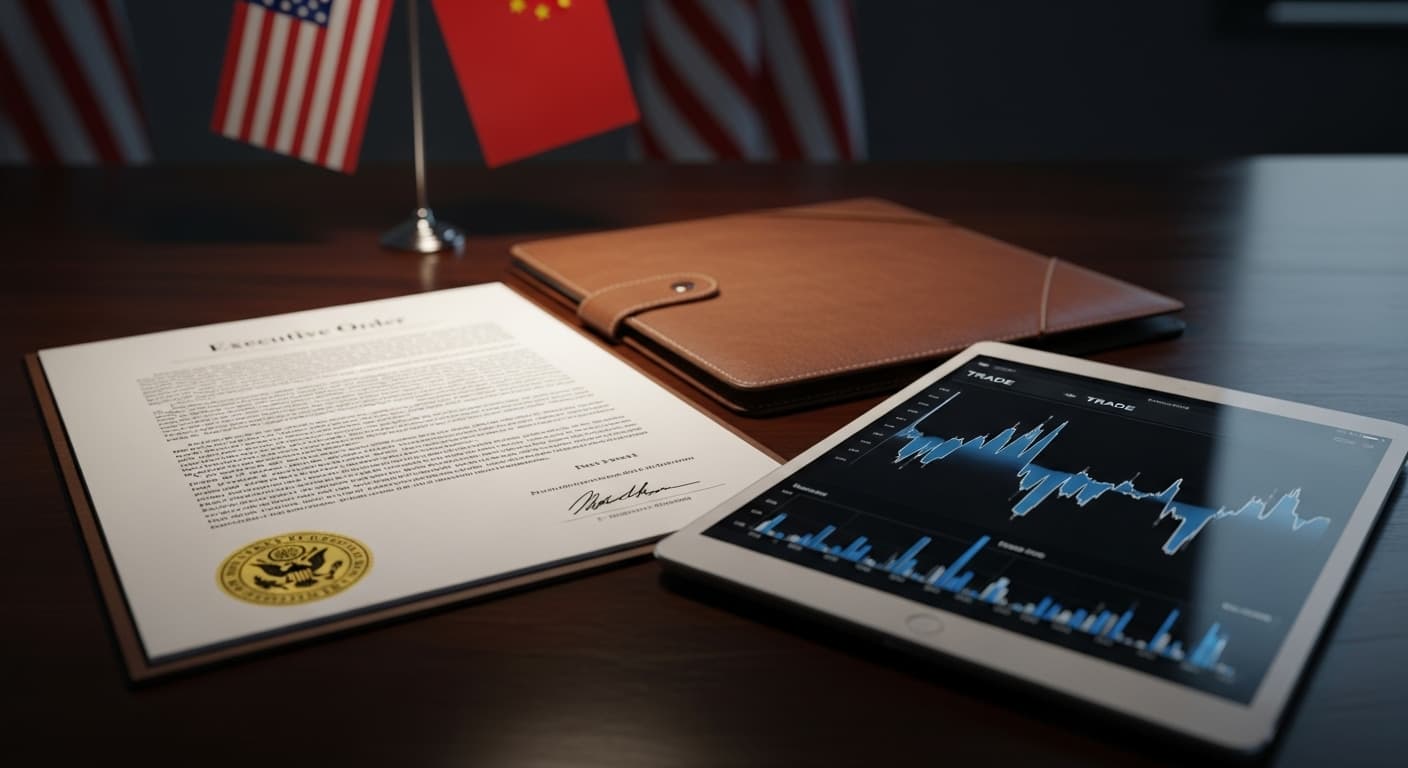
Executive Summary
President Trump issued executive orders on November 4, 2025, implementing the U.S.-China trade agreement with specific effective dates and conditions. The fentanyl tariff reduces from 20 percent to 10 percent at 12:01 a.m. EST on November 10, 2025, while the reciprocal tariff remains at 10 percent through November 10, 2026, preventing a scheduled increase to 34 percent. All provisions remain explicitly conditional on Chinese compliance and subject to presidential modification. This update provides critical implementation details for importers managing entry timing and compliance.
U.S.-China Trade Agreement: Executive Order Implementation Update
(美中贸易协议:行政命令实施更新)
Note: This article provides implementation updates to our previous analysis of the U.S.-China Trade and Economic Agreement: Comprehensive Analysis of Tariff Modifications, Regulatory Suspensions, and Commercial Commitments. Readers should review the prior article for comprehensive background on agreement provisions, agricultural commitments, export control modifications, and strategic implications.
1 · Executive Order Announcement: November 4, 2025
President Trump signed executive orders on November 4, 2025, providing the formal legal framework for implementing tariff provisions previously announced in the U.S.-China trade agreement.
What Changed from Previous Announcements
New Clarity Provided: The executive orders established specific details not previously confirmed:
Precise Effective Date and Time:
- Fentanyl Tariff: Effective 12:01 a.m. Eastern Standard Time on November 10, 2025
- Time Zone Specification: EST explicitly specified as determining time zone
- Entry/Withdrawal Application: Applies to goods entered or withdrawn from warehouse for consumption on or after this exact date/time
Prevented Rate Increase:
- Scheduled Escalation: Reciprocal tariff had been scheduled to increase from 10% to 34% on November 10, 2025
- 24 Percentage Point Avoidance: Executive order prevents this substantial increase
- Suspension Through: 12:01 a.m. EST on November 10, 2026
Explicit Conditionality: The executive orders formally state that provisions may be modified if:
- China fails to implement related commitments outlined in the trade agreement
- Modifications deemed necessary to address conditions underlying original tariff imposition
2 · Fentanyl Tariff Reduction: Implementation Specifics
Rate Change Details
What Changes on November 10:
- Previous Rate: 20 percent additional tariff on all Chinese imports
- New Rate: 10 percent additional tariff on all Chinese imports
- Reduction: 50 percent decrease in fentanyl-related tariff
- Effective Moment: 12:01 a.m. EST, November 10, 2025
Critical Entry Timing Considerations
Determining Which Rate Applies:
For Entry for Consumption:
- Before 12:01 a.m. EST Nov 10: 20 percent fentanyl tariff applies
- On or After 12:01 a.m. EST Nov 10: 10 percent fentanyl tariff applies
- Determining Factor: Date goods are entered for consumption
For Warehouse Withdrawals:
- Before 12:01 a.m. EST Nov 10: Withdrawals subject to 20 percent rate
- On or After 12:01 a.m. EST Nov 10: Withdrawals subject to 10 percent rate
- Strategic Opportunity: Importers with goods in bonded warehouse can time withdrawals to benefit from reduced rate
Immediate Action Items for Importers
Before November 10:
- Inventory Review: Identify goods currently in transit or bonded warehouse
- Entry Timing Analysis: Calculate duty savings from delaying entry until after November 10
- Broker Coordination: Ensure customs broker aware of timing optimization opportunities
- Documentation Preparation: Have entry documentation ready for prompt filing after November 10
On and After November 10:
- Rate Verification: Confirm 10 percent fentanyl tariff applied to entries
- System Updates: Verify internal systems updated with new rate
- Cost Model Updates: Update landed cost calculations reflecting reduced tariff
- Pricing Adjustments: Consider whether duty savings enable pricing adjustments
3 · Reciprocal Tariff: Significant Rate Increase Avoided
The 34 Percent Increase That Didn’t Happen
Critical Context: While much attention focuses on the fentanyl tariff reduction, the avoided reciprocal tariff increase represents even more significant cost savings.
What Was Scheduled:
- Original Rate: 10 percent reciprocal tariff on Chinese imports
- Scheduled Increase: Programmed to increase to 34 percent on November 10, 2025
- Automatic Implementation: Would have occurred without additional action
What Actually Happened:
- Rate Maintained: 10 percent rate continues
- Increase Prevented: 34 percent rate never implemented
- Suspension Period: Through 12:01 a.m. EST on November 10, 2026
Financial Impact:
- Duty Difference: 24 percentage points avoided
- Percentage Savings: Approximately 71 percent reduction versus scheduled rate
- Significance: For many importers, larger savings than fentanyl tariff reduction
Planning for November 2026 Expiration
One-Year Planning Horizon: Importers have certainty only through November 10, 2026.
Possible Post-November 2026 Scenarios:
Scenario 1: Extension (Most Likely)
- Further agreement extending 10 percent rate beyond 2026
- Likely advance announcement if negotiations successful
Scenario 2: Rate Increase
- Implementation of 34 percent rate or alternative higher rate
- Substantial cost increase requiring sourcing adjustments
Scenario 3: Modification
- Different rate structure based on negotiations or compliance
- Potentially sector-specific or graduated rates
Recommended Actions:
- Scenario Planning: Develop cost models for multiple rate scenarios
- Monitoring: Track negotiation progress throughout 2026
- Flexibility: Maintain supply chain flexibility for potential adjustments
- Diversification: Continue supply chain diversification efforts despite current stability
4 · Conditional Nature: Understanding the Fine Print
Explicit Conditions in Executive Orders
The November 4 executive orders explicitly state that tariff modifications may be changed based on two conditions:
Condition 1: Chinese Compliance Failure
- Trigger: If China fails to implement related commitments in the agreement
- Relevant Commitments: Particularly fentanyl precursor controls and agricultural purchases
- Authority: Presidential discretion to determine compliance adequacy
- Consequence: Potential tariff reinstatement or increase
Condition 2: Underlying Condition Assessment
- Trigger: If deemed necessary to address conditions underlying original tariff imposition
- Broad Authority: Covers national security, trade imbalance, or other justifications
- Presidential Discretion: Subjective determination by administration
- Consequence: Modifications possible with limited advance notice
What Importers Should Monitor
Compliance Indicators:
Fentanyl Precursor Controls:
- DEA data on fentanyl and precursor seizures
- U.S. government statements on Chinese cooperation
- Reports on Chinese export control enforcement
Agricultural Purchases:
- Monthly soybean purchase data
- USDA reports on Chinese agricultural imports
- Progress toward 12 million MT (2025) and 25 million MT (2026-2028) commitments
General Trade Relations:
- Administration statements on U.S.-China relations
- Trade deficit trends
- Geopolitical developments affecting bilateral relationship
Warning Signs:
- Critical U.S. government statements on Chinese compliance
- Continued high fentanyl flow data despite controls
- Shortfalls in agricultural purchase commitments
- Escalating rhetoric or new trade tensions
5 · Cumulative Duty Structure: Critical Reminder
These Modifications Don’t Eliminate Other Tariffs
Important Understanding: The executive order modifications apply in addition to other continuing duties:
All Chinese Imports Still Subject To:
-
Most-Favored-Nation (MFN) Duties
- Column 1 rates in Harmonized Tariff Schedule
- Rates vary by product (0-30%+)
- Unchanged by trade agreement
-
Section 301 Tariffs
- Rates from 7.5 percent to 100 percent
- Apply to hundreds of billions in annual imports
- Exclusions extended through November 10, 2026
- See previous article for detailed Section 301 analysis
-
Reciprocal Tariff
- Now 10 percent (not 34 percent)
- Through November 10, 2026
-
Fentanyl Tariff
- Now 10 percent (reduced from 20 percent)
- Effective November 10, 2025
Quick Calculation Reference
Example Total Duty Calculations:
Electronics (HTS 8517.12.00, not excluded):
- MFN: 0%
- Section 301 (List 3): 25%
- Reciprocal: 10%
- Fentanyl: 10% (was 20%)
- Total: 45% (was 55%)
Apparel (HTS 6203.42.40, not excluded):
- MFN: 16.6%
- Section 301 (List 4A): 7.5%
- Reciprocal: 10%
- Fentanyl: 10% (was 20%)
- Total: 44.1% (was 54.1%)
Furniture (HTS 9403.60.80, with Section 301 exclusion):
- MFN: 0%
- Section 301: 0% (excluded)
- Reciprocal: 10%
- Fentanyl: 10% (was 20%)
- Total: 20% (was 30%)
Key Takeaway: While reductions are meaningful, total tariff burdens remain substantial for most Chinese imports.
6 · Immediate Action Checklist
For Goods Entering Before November 10
- ✅ Accept 20% Fentanyl Tariff: Goods entered before deadline subject to higher rate
- ✅ Verify Entry Date: Ensure entry date correctly recorded
- ✅ Update Costing: Factor actual duties paid into cost accounting
For Goods Entering On or After November 10
- ✅ Confirm 10% Fentanyl Rate Applied: Verify customs broker applies correct reduced rate
- ✅ Entry Date Documentation: Ensure entry date clearly established as on/after November 10
- ✅ Duty Calculation Verification: Confirm all tariff layers correctly assessed
- ✅ Cost Model Updates: Update landed cost models with new duty structure
For Goods in Bonded Warehouse
- ✅ Withdrawal Timing Analysis: Calculate duty savings from delaying withdrawal
- ✅ Storage Cost Comparison: Balance duty savings against warehouse storage fees
- ✅ Strategic Timing: Plan withdrawal for optimal duty treatment
- ✅ Documentation Preparation: Prepare withdrawal paperwork in advance
For Long-Term Planning
- ✅ November 2026 Scenarios: Develop cost models for post-expiration scenarios
- ✅ Compliance Monitoring: Establish process for tracking Chinese compliance indicators
- ✅ Supply Chain Review: Assess whether current conditions warrant sourcing changes
- ✅ Advisor Consultation: Schedule regular check-ins with customs broker and trade counsel
7 · What to Watch Going Forward
Near-Term (Through February 2026)
Fentanyl Precursor Controls:
- Data on precursor chemical flows to North America
- Chinese enforcement actions and export licensing
- U.S. government assessments of Chinese cooperation
Agricultural Purchases:
- November-December 2025 soybean purchase progress
- Progress toward 12 million MT commitment for 2025
- Announcements on 2026 purchase planning
Specific Duty Methodology:
- Reminder: Specific duty methodology (fixed dollar amounts) expires February 28, 2026
- All imports then subject to ad valorem (percentage) duty calculation
- See previous article for specific vs. ad valorem analysis
Medium-Term (Through November 2026)
Reciprocal Tariff Extension:
- Negotiations on extending suspension beyond November 10, 2026
- Administration statements on reciprocal tariff future
- Industry advocacy for extension or elimination
Section 301 Exclusion Extension:
- Exclusions currently extended through November 10, 2026
- Watch for announcements on further extension or new exclusion process
- Some products’ economics significantly affected by exclusion status
Overall Compliance:
- Broader U.S.-China relationship developments
- Rare earth export control implementation
- Technology sector investigation termination compliance
Long-Term Strategic Considerations
Supply Chain Strategy:
- Despite current improvements, geopolitical risks persist
- Diversification remains prudent long-term strategy
- Balance current cost savings against future risk mitigation
2026 Expiration Planning:
- Begin scenario planning 6-9 months before November 2026
- Develop contingency plans for multiple post-expiration outcomes
- Maintain sourcing flexibility for potential adjustments
Conclusion: Implementation Clarity with Continuing Uncertainty
What We Now Know
The November 4 executive orders provide critical specificity:
- Exact effective date/time: 12:01 a.m. EST, November 10, 2025
- Precise entry application: Based on entry or withdrawal date
- Confirmed rate avoidance: 34 percent reciprocal tariff increase prevented
- Clear expiration: Reciprocal suspension through November 10, 2026
- Explicit conditionality: Formal statement of modification conditions
What Remains Uncertain
Despite implementation clarity, significant uncertainty continues:
- Chinese compliance: Whether China fully implements all commitments
- Post-2026 rates: What happens after reciprocal tariff suspension expires
- Modification triggers: Specific thresholds for presidential modifications
- Long-term stability: Broader U.S.-China relationship trajectory
The executive orders provide welcome clarity on implementation specifics while reinforcing the conditional nature of all provisions. Success requires both capitalizing on current opportunities and maintaining strategic preparedness for potential future changes.
Related Reading:
This analysis reflects President Trump’s November 4, 2025, executive orders implementing specific provisions of the U.S.-China trade agreement. The fentanyl tariff reduces to 10 percent at 12:01 a.m. EST on November 10, 2025, for goods entered or withdrawn from warehouse on or after that date/time. The reciprocal tariff maintains at 10 percent through 12:01 a.m. EST on November 10, 2026, preventing a scheduled increase to 34 percent. All provisions remain explicitly conditional on Chinese compliance and subject to presidential modification. Importers should consult with qualified customs brokers or trade attorneys for guidance on specific situations. Information current as of publication date.



